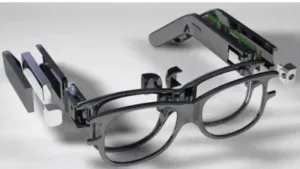At this time, Alpha Labs (Palo Alto, CA) is a small company, consisting of just three engineers and a marketing director. None-the-less, the company’s plans are not small. Currently under development is a product called Alpha Glass, which are smartglasses having a “casual” design with on-lens displays that are claimed to have a wide field of view.

The Alpha Glass operates in conjunction with and through a Bluetooth connection to a companion smart device such as a smartphone or smartwatch.
A noted feature of the Alpha Glasses is that the much of the optical system is integrated into the foldable frame of the smartglasses. This is accomplished through the use of what the company calls Separated Modular Optical System (SMOS) technology.
The SMOS structure starts with a micro OLED display with SXGA (1280×1024) resolution located inside the frames. “The image of the display then enters the collimator lens located in the nose bridge. The collimator lens adjusts the image and inserts it into a spectacle lens with a wave-guide structure.” These optics act as a combiner and serves to project the image into the eyes of user.
The resulting image is reported to have a wide, 30º FOV. To put this FOV into context, the company points out that this screen size is 4X larger than that was the Google Glass. The wide FOV is achieved in part by “reducing the size of the existing integrated structure and separating it into display, control and combiners.” The structure of the smartglasses in illustrated in the figures below.
Structure of the Alpha Glass smartglasses.
Company literature states that these optics constitute the “World’s Smallest AR Vision Module.” Apparently, the volume is 50% smaller than other systems having a 30° FOV. Elements of the SMOS technology are patented in Korea and applications are pending in the U.S. and Japan.
A video is appended to the end of this article that illustrates and discusses the Alpha Glass smartglasses.
Other features and specifications of the Alpha Glasses include the following:
- Image brightness: ~1,000 cd/m²
- Image contrast ratio: 10,000:1
- Frame rate: 60 fps
- 3-axis accelerometer, 3-axis gyroscope, 3-axis compass
- 4 direction touch pad (up, down, left and right)
- Bluetooth 4.0
- MEMS microphone (with an always ready voice command trigger)
- Bone conduction speaker
- Li-polymer battery (3.7 V and ~1,000 mAh)
- Charge via USB Micro-B (typical smartglasses operating lifetime ~6 hours)
- 1 GHz A7 Quad, 2 GB RAM, 16 GB eMMC
- Weight ~80 g
- 5 megapixel fixed focus CMOS camera
Gesture control is possible through a Bluetooth connection with other smart devices.
The Alpha Glass uses the Android 5.1 OS. It is also compatible with Android 4.3+ and iOS 7+. Alpha Glass also uses a customized user interface launcher called Mod UI. The Mod UI includes five default Mods: home, game, camera, navigation and health. Depending on Mod category, developers can design both regular applications and AR applications. A free smartphone based companion app will help users customize the default app of each Mod thus allowing them to easily control their Alpha Glass. The companion app resides in a smartphone that is connected to Alpha Glass by Bluetooth. This connection capability also allows users to instantly save photos taken with their Alpha Glass to their smartphone.
The company states that it is possible to include a prescription lens in the smartglasses. They go on to explain that the cost to manufacture prescription smartglasses is high. As an alternative, the company suggests a contact lens or clip lens. The company is considering including a clip lens with the Alpha Glass as a stretch goal.
Uses of the Alpha Glass smartglasses include AR entertainment, HUD navigation, interaction on social media, as a private AI assistant and for health monitoring. The smartglasses contain a front facing POV camera that can be used to take photos, videos and read QR codes.
The company is currently raising funds by way of an Kickstarter campaign that can be found here. The funds are intended to bring the Alpha Glass into production. At the time this article is written, 37 backers have pledged $19,668 towards a goal of $100,000. The amount pledged has been slowly increasing during the period that I have watched the site. None-the-less, the project will fund only if the goal is fully reached by August 4th. -Arthur Berman

